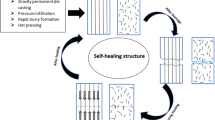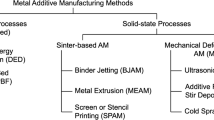Abstract
Composites formed by infiltration of an array of fine alumina fibres with aluminium alloy melts have been investigated in terms of fabrication characteristics, microstructural features and mechanical properties. A production method has been developed in which the application of pressure ensures very low porosity levels and strong fibre-matrix bonding. Details of the transport phenomena occurring during fabrication have been explored with a view to optimizing selection of applied pressure, thermal fields, alloy composition and the structure of the fibrous preform. Microstructural examinations revealed an intimate fibre-matrix bond, but the virtual absence of any chemical reaction at the interface. Comparison of property measurements with data from unreinforced alloys revealed increased elastic moduli and marked improvement in tensile strength at elevated temperature, accompanied by reductions in elongation.
Similar content being viewed by others
References
Data sheet on RF Saffil, ICI Mond division, Runcorn, Cheshire, UK (1982).
T. Donomoto, K. Funatani, N. Miura andN. Miyake, “Ceramic Fibre Reinforced Piston for High Performance Diesel Engines”, paper 830252, SAE Int. Congress and Exposition, Detroit, 28 February to 4 March (1983).
H. Fukunaga andM. Kuriyama,Bull. JSME 25 (1982) 842.
H. Fukunaga, “Rotating Bending Fatigue Strength of Copper-precipitated Devitroceramic Fibre Reinforced Aluminium”, 24th Japanese Congress on Materials Research on Metallic Materials, March (1981) pp. 130–3.
C. G. Levi, G. J. Abbaschian andR. Mehrabian,Met. Trans. 9A (1978) 697.
F. M. Hosking, F. Folgar Portillo, R. Wunderlin andR. Mehrabian,J. Mater. Sci. 17 (1982) 477.
K. J. Bhansali andR. Mehrabian,J. Metals 34(9) (1982) 30.
D. Webster,Met. Trans. 13A (1982) 1511.
B. F. Quigley, G. J. Abbaschian, R. Wunderlin andR. Mehrabian,ibid. 13A (1982) 93.
G. H. Pigott andJ. Ishmael, “A Strategy for the Design and Evaluation of a Safe Inorganic Fibre”, 5th International Symposium on Inhaled Particles, Cardiff, September (1980).
K. Prabriputaloong andM. R. Piggott,Surf. Sci. 44 (1974) 585.
S. M. Wolf, A. P. Levitt andJ. Brown,Chem. Eng. Prog. 62 (1966) 74.
J. Brennan andJ. A. Pask,J. Amer. Ceram. Soc. 51 (1968) 569.
S. K. Rhee,ibid. 55 (1972) 300.
W. Kohler,Aluminium 7 (1975) 443.
R. Mehrabian, “A Fundamental Study of a New Fabrication Technique for Fiber Reinforced Aluminium Matrix Composites”, Final Report on US Army Research Office Contract DAAG29-76-G-0170, April (1980).
S. V. Pepper,J. Appl. Phys. 47 (1976) 801.
A. Munitz, M. Metzger andR. Mehrabian,Met. Trans. 10A (1979) 1491.
A. K. Dhingra andW. H. Kreuger, “Fiber FP Continuous Yarn”, Report by E. I. DuPont de Nemours & Co. Inc., Wilmington, DL (1974).
UK Patent No. 1 567 328, May (1980).
R. W. Grimshaw andC. Poole, UK Patent No. 1 595 280, August (1981).
K. Ban, A. Daimara, Y. Muraoka andN. Miyake, UK Patent No. 2 088 761, June (1982).
K. I. Portnoi, S. E. Salibekov, I. L. Swetlov andV. M. Chubarov, “Structure and Properties of Composite Materials” (Mashinostroenie, Moscow, 1979) in Russian.
S. T. Mileiko, in “Fabrication of Composites”, edited by A. Kelly and S. T. Mileiko (North Holland, Amsterdam, 1983) p. 287.
J. Szekely, “Fluid Flow Phenomena in Metals Processing” (Academic Press, New York, 1979) p. 237.
S. Ergun,Chem. Eng. Prog. 48 (1952) 93.
G. H. Geiger andD. R. Poirier, “Transport Phenomena in Metallurgy” (Addison-Wesley, New York, 1973) p. 94.
M. P. Seah andW. A. Dench,Surf. Interface Anal. 1 (1979) 2.
J. F. Watts andJ. E. Castle,J. Mater. Sci. 18 (1983) 2987.
W. H. J. Vernon, F. Wormwell andT. J. Nurse,J. Chem. Soc. (1939) 621.
W. R. Symes andE. Rastetter, in 24th International Colloquium on Refractories, Aachen, September 1981.
R. J. Arsenault andR. M. Fisher,Scripta Metall. 17 (1983) 67.
R. Elliott,Int. Met. Rev 22 (1977) 161.
W. Kurz andD. J. Fisher,Int. Met. Rev. 24 (1979) 177.
R. M. Christensen andR. M. Waals,J. Comp. Mater. 6 (1972) 518.
Author information
Authors and Affiliations
Rights and permissions
About this article
Cite this article
Clyne, T.W., Bader, M.G., Cappleman, G.R. et al. The use of a δ-alumina fibre for metal-matrix composites. J Mater Sci 20, 85–96 (1985). https://doi.org/10.1007/BF00555902
Received:
Accepted:
Issue Date:
DOI: https://doi.org/10.1007/BF00555902




